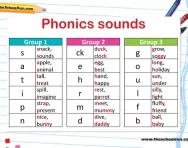Important update from TheSchoolRun
For the past 13 years, TheSchoolRun has been run by a small team of mums working from home, dedicated to providing quality educational resources to primary school parents. Unfortunately, rising supplier costs and falling revenue have made it impossible for us to continue operating, and we’ve had to make the difficult decision to close. The good news: We’ve arranged for another educational provider to take over many of our resources. These will be hosted on a new portal, where the content will be updated and expanded to support your child’s learning.
What this means for subscribers:
- Your subscription is still active, and for now, you can keep using the website as normal — just log in with your usual details to access all our articles and resources*.
- In a few months, all resources will move to the new portal. You’ll continue to have access there until your subscription ends. We’ll send you full details nearer the time.
- As a thank you for your support, we’ll also be sending you 16 primary school eBooks (worth £108.84) to download and keep.
A few changes to be aware of:
- The Learning Journey weekly email has ended, but your child’s plan will still be updated on your dashboard each Monday. Just log in to see the recommended worksheets.
- The 11+ weekly emails have now ended. We sent you all the remaining emails in the series at the end of March — please check your inbox (and spam folder) if you haven’t seen them. You can also follow the full programme here: 11+ Learning Journey.
If you have any questions, please contact us at [email protected]. Thank you for being part of our journey it’s been a privilege to support your family’s learning.
*If you need to reset your password, it will still work as usual. Please check your spam folder if the reset email doesn’t appear in your inbox.
How being bilingual affects your child’s education

Across the UK, about 20 per cent of primary school children don’t speak English as their first language. Some were born here or have lived here for some time but use another language at home; others are new arrivals to the UK. So how might being an English as an additional language (EAL) learner affect your child’s education?
EAL children and the curriculum
All maintained schools in the UK are obliged to follow the national curriculum. ‘There is no separate or amended curriculum for EAL children, and they must be able to access all areas of the curriculum,’ says Diane Leedham, a teacher and EAL consultant and committee member of Naldic, the National Association for Language Development in the Curriculum. ‘It’s up to schools and teachers to adapt their lesson plans and teaching to make sure every child is learning from the national curriculum.’


Start a unique learning programme!
- Weekly programme for each school year
- Worksheets sent direct to your inbox
- Keeps your child's learning on track
EAL children also have to take the same national assessments as their peers, including the Year 1 phonics screening check and KS1 SATs and KS2 SATs in English and maths. In KS1, children may be able to have the test instructions for the English assessments translated, but will have to complete the exam in English. Schools can translate the whole maths assessment for children who regularly have their classwork translated.
In KS2, your child won’t be entered for SATs if they’re working below the level of the tests, or if they have only recently arrived in the country. Otherwise, they will sit the same English tests as everyone else, although access arrangements such as translation can be arranged for the maths tests.
Progress and positives
The good news is that many EAL children tend to make good progress at school. In KS2, 73 per cent achieve or exceed the expected levels in all three core subjects, compared with 76 per cent of native English speakers – effectively ‘catching up’ from where they were at the end of Key Stage 1. The biggest leap is in reading, with smaller jumps in writing and maths.
EAL children also have other advantages in the classroom. ‘Bilingual children have two comparative systems of language to use, which can impact on higher level thinking and interpretation,’ says Diane. ‘They also tend to have a better implicit understanding of grammar and structure.’
Classroom challenges
EAL children may face a number of challenges in the classroom, says Diane. ‘Children who have been in a UK school for some time may be very fluent English speakers, but often, their vocabulary, writing and reading comprehension isn’t at the same level,’ Diane explains. ‘This is sometimes missed by teachers.’ Interestingly, EAL children perform just as well in the KS1 phonics screening check as native English speakers, which is another cause of potential problems with reading comprehension being overlooked.
Children who are new to the UK school system may face more obvious barriers. ‘They are faced with mastering a new language very quickly,’ Diane says. In addition, children in many other countries don’t start formal education until much later than UK children. They may have to join a KS1 class straight from a more nursery-like environment in their home country, and adapt to a very different way of learning.
Language challenges don’t just affect English and literacy; they can also have an impact on how your child progresses in subjects like maths and science. ‘Although the concepts may be the same, they need to learn a new language surrounding them,’ Diane explains.
Cultural issues may also play a part. For example, a child who moves to the UK in KS2 may be stumped by a task that requires them to write their own version of Little Red Riding Hood if they didn’t learn English-style traditional tales at the pre-school stage.
Support for your child
Since 2013, there has been no central policy on whether schools should be given extra money to support EAL learners. Instead, individual areas decide:
- whether to allocate money to EAL in schools
- which children will be eligible support, based on how long they have lived here
- how much money to allocate.
‘Some schools have their own EAL specialists who have professional knowledge and are trained in language development,’ says Diane. ‘Others are able to access support from trained professionals through the local authorities. But often, financial restraints and lack of resources means that support for EAL children is provided by teaching assistants who may lack the specialist knowledge they need.’
Most importantly, EAL children should be taught in the mainstream classroom, alongside their peers. ‘It’s more effective to learn a new language in a public setting,’ Diane explains. Good teachers will tailor the lesson to suit each child: for example, your child might be encouraged to plan a writing task in their own language so they can express their thoughts and ideas in their most fluent language, and then be given a writing frame to help them put it into English. Some schools also run booster classes or buddy systems to help EAL children develop their English.
If you’re concerned that your child is not getting the right support, speak to their teacher about how they can help. There is also a lot that you can do to support your child at home. ‘The crucial thing is to provide a language-rich environment, communicating in your strongest language so your child gets to use language at the highest level possible,’ Diane says. You can also find resources on the internet, and use audio books and bilingual reading books, like those from Mantra Lingua.
You can find more information about supporting your child, both through school and with their home learning, at www.eal.britishcouncil.org








